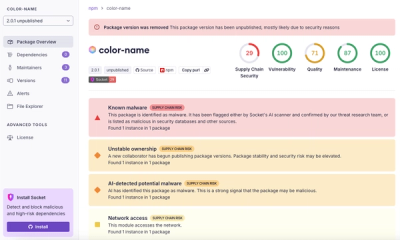
Research
/Security News
npm Author Qix Compromised via Phishing Email in Major Supply Chain Attack
npm author Qix’s account was compromised, with malicious versions of popular packages like chalk-template, color-convert, and strip-ansi published.
webpack-to-ardoq
Advanced tools
1. `npm install` 2. Copy `config-sample.json` to `config.json` 3. Choose an org to use, and create a folder for the new workspaces 4. Generate an API token for the script, and configure the `connection.token` property in the config file 5. Create two empt
npm installconfig-sample.json to config.jsonconnection.token property in the config fileARDOQ.context.workspaces().reduce((a,w)=>a+'\n'+Object.values(w.getModel().getAllTypes()).reduce((b,t)=>`${b}\n ${t.name} - ${t.id}`,w.name()),'')
ARDOQ.context.workspaces().reduce((a,w)=>a+'\n'+Object.values(w.getModel().getReferenceTypes()).reduce((b,t)=>`${b}\n ${t.name} - ${t.id}`,w.name()),'')
npm start /path-to/ardoq-front/ ./config.json [...options]npm start /path-to/ardoq-front/ ./config.json dryRunnpm start /path-to/ardoq-front/ ./config.json clearCacheRun npm run build to transpile files in /src to ES6 in /dist.
FAQs
1. `npm install` 2. Copy `config-sample.json` to `config.json` 3. Choose an org to use, and create a folder for the new workspaces 4. Generate an API token for the script, and configure the `connection.token` property in the config file 5. Create two empt
The npm package webpack-to-ardoq receives a total of 2 weekly downloads. As such, webpack-to-ardoq popularity was classified as not popular.
We found that webpack-to-ardoq demonstrated a not healthy version release cadence and project activity because the last version was released a year ago. It has 12 open source maintainers collaborating on the project.
Did you know?

Socket for GitHub automatically highlights issues in each pull request and monitors the health of all your open source dependencies. Discover the contents of your packages and block harmful activity before you install or update your dependencies.

Research
/Security News
npm author Qix’s account was compromised, with malicious versions of popular packages like chalk-template, color-convert, and strip-ansi published.

Research
Four npm packages disguised as cryptographic tools steal developer credentials and send them to attacker-controlled Telegram infrastructure.

Security News
Ruby maintainers from Bundler and rbenv teams are building rv to bring Python uv's speed and unified tooling approach to Ruby development.